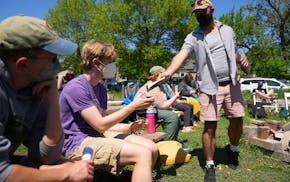Calls and visits to Minnesota medical clinics increased midweek as people inhaling historically bad air could no longer tolerate it.
"You breathe the stuff in yesterday, and today stuff is flaring," said Dr. Andrew Stiehm, a pulmonologist with Allina Health in St. Paul.
Air quality levels in the Twin Cities nudged into the "very unhealthy" range at one point on Wednesday as smoke from Canadian wildfires blew south.
Nick Witcraft, an air quality meteorologist with the MPCA, said Wednesday's smoke was the worst on record for the Twin Cities. At 6 p.m. Wednesday, St. Paul had the worst air quality in the United States, with a score of 256, according to AirNow.gov, the official U.S. air-quality index site. The air had cleared markedly by mid-day Thursday, with continued air quality alerts for southwestern Minnesota.
Clinicians expected a delayed effect as the dirty air took its toll on patients with asthma, COPD and other breathing-related conditions.
Hospital emergency rooms didn't see a dramatic increase, though more than 30 patients came to Allina's two Mercy hospital campuses in Coon Rapids and Fridley with breathing-related problems Wednesday.
Hennepin Health spokeswoman Christine Hill said she was "wheezing like crazy" but so far the downtown Minneapolis ER hadn't encountered a substantial increase in patients with conditions related to the air quality.
Organizations across Minnesota may have helped by taking the rare step of cancelling outdoor events in response to the air quality warnings. Youth soccer fields across the Twin Cities were deserted as teams and leagues cancelled practices and games.
Patients with lung problems may have avoided severe flareups requiring ER visits because they were prepared, especially after earlier air quality alerts this spring, said Dr. Hem Desai, an M Health Fairview pulmonologist. "This has been an ongoing situation for the last couple of weeks."
Even so, many patients with asthma alerted him this week that they were using rescue medications beyond their routine inhalers. Some needed refills because those emergency supplies had expired.
Stiehm said anyone with long-term breathing issues experiencing symptoms that are "clearly worse" than expected should check in with their doctors. For people with asthma, frequent "night awakenings" with flareups is one indicator. Blood oxygen readings of 92 or lower are another warning sign for people with chronic breathing problems.
"Particularly in the wake of COVID, a lot of people have their pulse oximeters," Stiehm said.
Staff writer Paul Walsh contributed to this report.

Want to share info with the Star Tribune? How to do it securely

'Safe recovery sites' would offer syringes, naloxone and more to people using drugs. The plan could be in peril.
New Minnesota GOP leaders seek peace with party's anti-establishment wing

Who is Republican Lisa Demuth, Minnesota's first House speaker of color?

